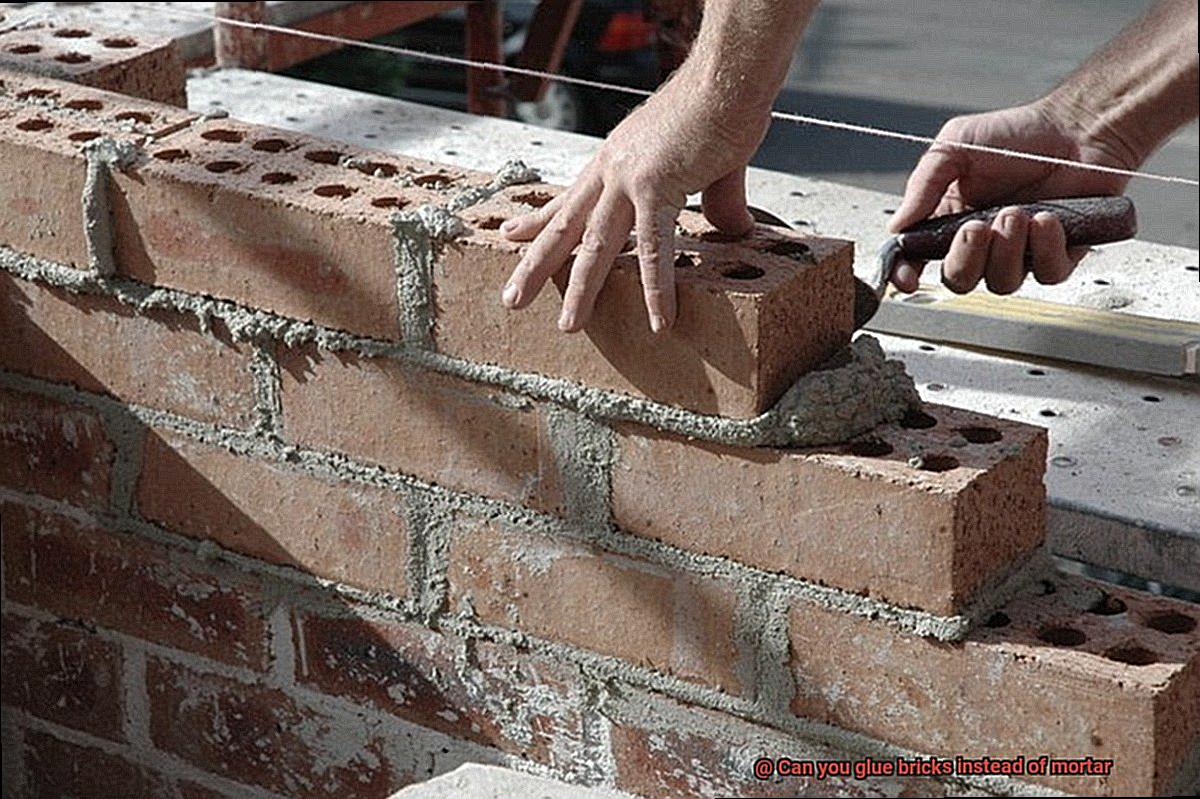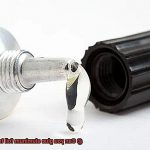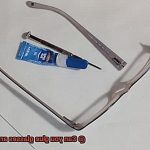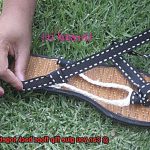Bricks and mortar have been inseparable partners in construction since time immemorial. But in a world where innovation is the name of the game, it’s only natural to wonder if there’s a different way to join those trusty bricks together.
In this blog post, we’re diving headfirst into an intriguing idea: can glue take the place of mortar when it comes to bonding bricks? It may sound like something out of a DIY enthusiast’s wildest dreams, but believe it or not, there are some compelling arguments for using adhesive materials instead. By exploring the advantages and potential challenges that come with gluing bricks together, we hope to shed some light on this captivating topic.
So buckle up and get ready as we embark on a journey to uncover whether glue could be the game-changer that revolutionizes the future of construction. Will this unconventional approach prove fruitful or fizzle out like a fleeting thought? Let’s dig in and find out.
What is Mortar and Why It Is Used in Brick Construction?
Contents
- 1 What is Mortar and Why It Is Used in Brick Construction?
- 2 Adhesive vs Mortar: Pros and Cons
- 3 Factors to Consider When Deciding Between Adhesive and Mortar
- 4 Structural Stability
- 5 Flexibility and Strength
- 6 Moisture Protection
- 7 Replacement of Individual Bricks
- 8 Specialized Adhesives for Specific Types of Brick Applications
- 9 Conclusion
In the realm of brick construction, there exists a humble yet mighty substance that holds it all together. Mortar, a seemingly unremarkable paste made from the harmonious blend of cement, sand, and water, plays a paramount role in erecting robust and enduring structures. In this captivating exploration, we will delve into the significance of mortar in brick construction, uncovering its multifaceted functions, unparalleled benefits, and its unrivaled superiority over alternative adhesives.
Binding Bricks Together:
Mortar emerges as an unwavering adhesive force that unites bricks, forging an unyielding structure. It effortlessly fills the gaps between bricks, ensuring their steadfast placement and establishing a cohesive whole. Without mortar, bricks would languish as mere isolated blocks precariously stacked upon one another, bereft of stability or purpose.

Load Distribution:
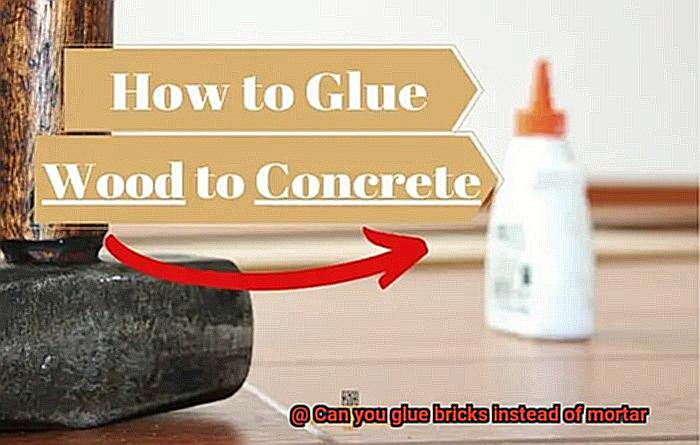
One of the crowning achievements of mortar lies in its ability to uniformly distribute loads across bricks. As external forces such as gales or ground settlement exert pressure upon the edifice, mortar deftly transfers the weight from one brick to another with seamless efficacy. This equal dissemination of loads forestalls the emergence of cracks and safeguards the overall integrity of the building.
Thermal Insulation:
Mortar’s ingenious air pockets serve as ethereal guardians, regulating temperatures within the very walls they embrace. By diminishing heat transfer, mortar bestows respite amid blistering summers and warmth amidst wintry chills. This energy-efficient quality not only enhances comfort but also reduces utility costs, unveiling a harmonious union between functionality and frugality.
Water Resistance:
Mortar takes on the pivotal role of warding off moisture infiltration, bestowing upon structures an indomitable shield against water’s relentless advances. By fortifying the gaps between bricks, mortar erects an impermeable barrier, fending off the ravages of torrential downpours and oppressive humidity. This steadfast defense safeguards against potential damage, ensuring the structural integrity remains unscathed.
Aesthetics:
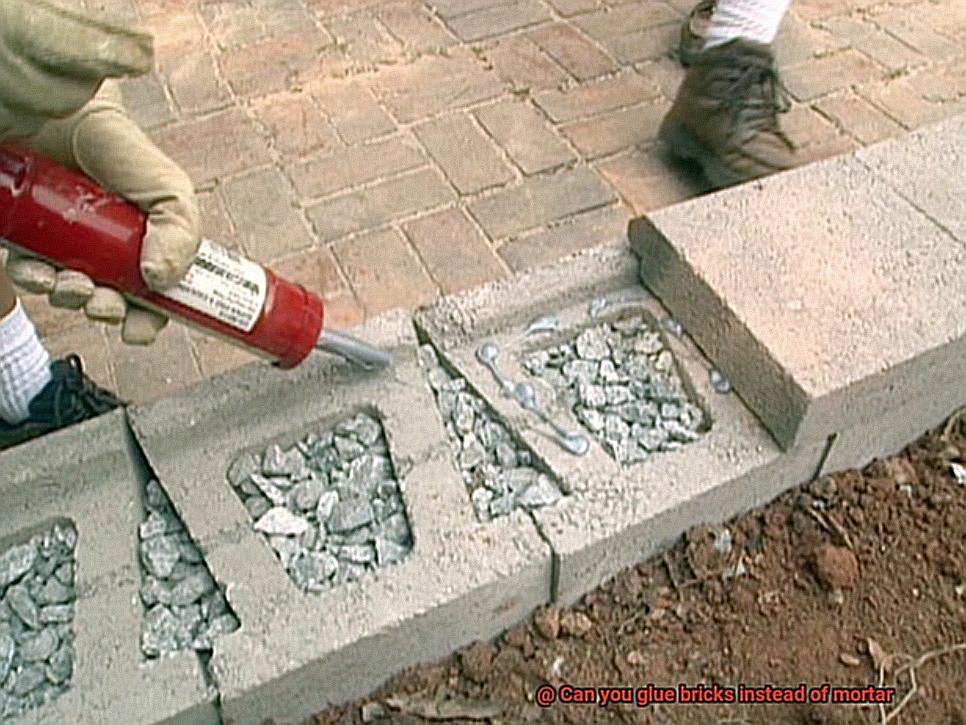
Beyond its utilitarian prowess, mortar emerges as a silent maestro, orchestrating the visual allure of brick constructions. It deftly fills irregularities and crevices between bricks, bequeathing upon walls a seamless and uniform finish. Moreover, mortar’s versatility knows no bounds as it can be imbued with vibrant hues or textured surfaces, unveiling a limitless realm of design possibilities and architectural creativity.
Adhesive vs Mortar: Pros and Cons
When it comes to bonding bricks in construction projects, two main options are commonly used: adhesive and mortar. Both have their distinct advantages and disadvantages, which must be carefully considered. Factors such as ease of use, curing time, flexibility, durability, breathability, repairability, aesthetics, and cost play a significant role in deciding between adhesive and mortar.
Advantages of Adhesive:
- Ease of use: Adhesive eliminates the need for mixing or preparation like mortar. It can be applied directly onto the bricks, saving time and effort.
- Faster curing time: Adhesive dries quickly, forming a strong bond between the bricks in less time compared to mortar.
- Flexibility: With its ability to withstand movement and vibrations, adhesive is an excellent choice for areas prone to external forces like earthquakes.
- Durability: Adhesive’s resistance to water and weather conditions makes it a reliable choice for outdoor applications.
Disadvantages of Adhesive:
- Lack of breathability: Unlike mortar, adhesive prevents moisture from evaporating between bricks, potentially leading to moisture-related issues over time.
- Difficulty in repair or replacement: Removing a single brick bonded with adhesive without damaging the surrounding ones can be challenging, making repairs or replacements more complicated.
- Aesthetics: While adhesive offers a seamless appearance, some prefer the traditional look of mortar joints between bricks for a more classic and appealing visual appeal.
- Cost: Adhesive tends to be more expensive than mortar, impacting the overall budget of a construction project.
Factors to Consider When Deciding Between Adhesive and Mortar
When it comes to deciding between adhesive and mortar for your construction project, there are several factors to consider that can help you make an informed decision. Let’s dive into the key factors that can influence your choice.
First and foremost, strength and durability are crucial considerations. Mortar, with its combination of cement, sand, and water, has been a tried and true bonding option for centuries. It offers robust bonding capabilities, making it suitable for handling heavy loads and resistant to weathering. On the other hand, adhesives like epoxy or polyurethane-based products have gained popularity for their high strength. However, it’s essential to choose an adhesive specifically designed for use with bricks or masonry materials to ensure optimal performance.
Flexibility is another factor to take into account. Mortar provides a certain degree of flexibility, allowing for movement and expansion without compromising the structure’s integrity. This is particularly important in earthquake-prone areas or regions with significant temperature fluctuations. Adhesives generally offer less flexibility, so it’s crucial to assess the project’s specific requirements and consult experts if movement is expected.
Ease of application is also an important consideration. Mortar requires mixing with water to achieve the right consistency before applying it to bricks or stones. It takes skill and experience to ensure a secure bond. Adhesives, on the other hand, often come ready-to-use and can be applied directly with a caulking gun or trowel. They’re more convenient for DIY enthusiasts or small-scale projects.
Time considerations play a significant role as well. Mortar typically requires curing time, which can range from a few hours to several days depending on the product and environmental conditions. This can slow down your project and require extra precautions during the curing process. Adhesives often offer quicker bonding times, allowing for immediate use or further construction. However, it’s crucial to follow the manufacturer’s instructions regarding curing times and load-bearing capacity.
Lastly, aesthetics should not be overlooked. Mortar joints are visible and can greatly impact the overall appearance of your brickwork or stonework. Mortar allows for various finishes, such as flush, recessed, or struck joints, which can enhance the architectural style. Adhesives may provide a more seamless and uniform appearance as they don’t require visible joints. Consider your desired aesthetic and consult with professionals for guidance.
Structural Stability
When it comes to constructing buildings, the classic combination of bricks and mortar is often seen as the gold standard for stability and durability. However, an alternative method has gained traction in recent years – using glue instead of mortar. While this approach may offer time and cost-saving benefits, it is crucial to consider several key factors when assessing the structural stability of buildings constructed with glued bricks.
The Power of Adhesive Strength:
The strength of the adhesive used is a crucial factor to consider. It must withstand the weight and pressure exerted on the structure over time. Choosing an adhesive designed for structural applications, rigorously tested for reliability, is essential.
Compatibility Matters:
The compatibility between the adhesive and bricks is another vital consideration. Different adhesives may have varying levels of compatibility with different brick types. Selecting an adhesive that forms a strong bond with the specific bricks being used ensures overall strength and stability.
Battling Environmental Challenges:
Environmental factors like temperature changes, moisture, and humidity can significantly impact the bond strength between glued bricks. An adhesive capable of withstanding these conditions without deterioration is crucial. Additionally, accounting for material expansion and contraction due to temperature changes helps prevent structural issues.
Flexibility and Fire Resistance:
Compared to traditional mortar, glued bricks may have limited flexibility, potentially leading to cracking or other problems. Mortar allows for movement and settling, absorbing stresses and preventing damage. Additionally, mortar acts as a fire barrier, slowing down fire spread within a building. Glued bricks may not offer the same fire resistance, necessitating compliance with fire safety regulations.
Knowledge is Compliance:
Before embracing glue as the construction method of choice, consulting professionals and ensuring compliance with local building codes and regulations is crucial. These regulations often have specific requirements for adhesive use in construction. Non-compliance may result in legal issues or problems with insurance coverage.
Flexibility and Strength
Today, we’ll delve into this topic and uncover why mortar reigns supreme in the realm of flexibility and strength.

Let’s start with flexibility—a crucial aspect of brick construction. Bricks are subject to expansion and contraction due to various factors like temperature changes, settling, and even minor earthquakes. Here’s where mortar steps in as the star of the show. Its magnificent blend of cement, sand, water, and other additives creates a bond that not only holds the bricks together but also allows for movement. Think of it as a flexible backbone for your brick structure, gracefully accommodating the shifting needs of your construction.
Now, let’s examine glue in comparison. While it may provide an initial strong bond, glue lacks the flexibility that mortar offers. Imagine your building swaying with the wind or trembling in response to the earth’s rumble. Mortar acts as a shock absorber, effortlessly adapting to these movements without compromising the integrity of your brickwork. On the other hand, glue isn’t engineered to handle such situations and may result in cracks or even catastrophic failure over time.
But that’s not all—strength is another defining characteristic we must consider. Mortar is designed to evenly distribute weight across each brick, acting like a superhero cape protecting them from cracks or breakage under pressure. Glue, however, may not possess the same load-bearing capacity. Picture your beautiful brick structure collapsing under its own weight because you opted for glue instead of mortar—a decision akin to wearing flip-flops on a construction site instead of sturdy steel-toed boots.
And let’s not forget about durability. Mortar has withstood the test of time, my friends. It has been utilized for centuries in brick construction and has proven its worthiness repeatedly. On the other hand, glue may be a newcomer to the game, lacking the same rigorous testing and time-honored legacy. Would you entrust your precious building to an unproven rookie? I think not.
Moisture Protection
Moisture protection is a critical consideration when constructing brick structures. Building with bricks requires a method that not only creates a strong bond but also defends against the detrimental effects of moisture. While traditional mortar has long been the go-to choice for this purpose, some may question whether gluing bricks can offer comparable protection.
When it comes to moisture protection, mortar reigns supreme. Its formulation is specifically designed to withstand the negative impact of moisture and prevent water from seeping into the structure. With its waterproofing additives, mortar acts as a trusty sidekick, providing a reliable barrier against water penetration. This superhero-like substance ensures the longevity and stability of the brickwork.
In contrast, relying solely on adhesives for moisture protection may prove inadequate. While certain adhesives claim to offer protection, they may lack the durability and resistance to moisture that mortar provides. Adhesives can crumble under pressure or fail to withstand fluctuating weather conditions. Moreover, they often pale in comparison to mortar’s ability to maintain structural integrity and provide strength.
But the benefits of mortar extend beyond just moisture protection. Imagine having a flexible cushion between bricks that allows for movement without causing cracks or damage. Mortar offers precisely that, making it particularly valuable in earthquake-prone regions. Additionally, mortar boasts thermal insulation properties, enhancing energy efficiency by reducing heat transfer.
Replacement of Individual Bricks
When it comes to replacing individual bricks in a structure, one must carefully consider the bonding material of choice. While glue may appear to be a quick fix, mortar reigns supreme in this battle. In this informative post, we will explore why mortar is the recommended option over glue, delving into its exceptional properties and advantages.
The Power of Mortar:
Mortar, composed of cement, sand, and water, is specifically designed for bricklaying. Its unique composition creates a paste-like consistency that not only fills gaps but also forms a robust bond between bricks.
Flexibility and Durability:
Unlike glue, mortar possesses the remarkable ability to absorb moisture and adapt to temperature fluctuations. This flexibility is essential for withstanding the stresses and movements that naturally occur within structures over time. Furthermore, extensive testing has proven that mortar boasts exceptional strength and durability, ensuring the stability and integrity of the entire structure.
Filling Gaps and Adhering to Uneven Surfaces:
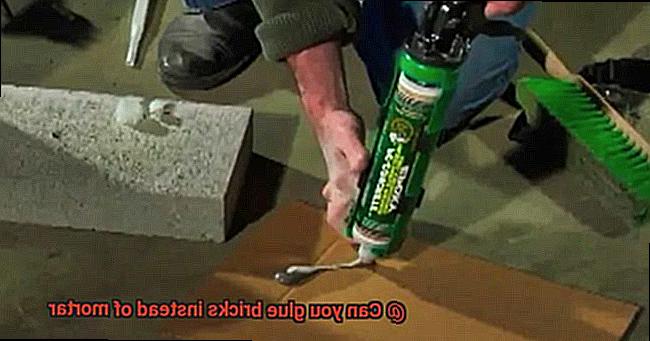
Mortar excels at filling gaps and securely adhering to uneven surfaces, guaranteeing a strong connection between bricks. Conversely, glue may struggle to effectively fill gaps, potentially compromising the overall stability of the structure.
Compatibility Matters:
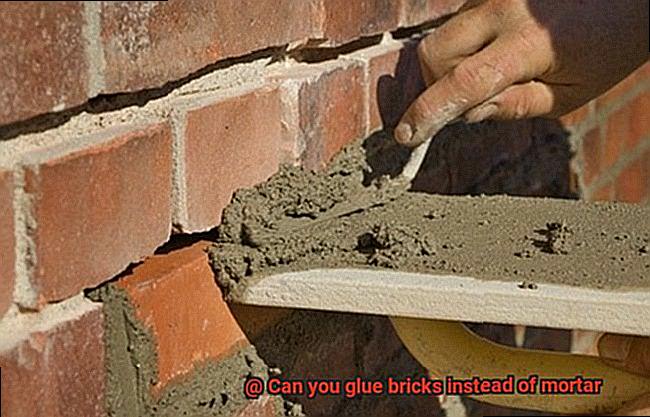
While glue may struggle to adhere to certain types of bricks or surfaces, mortar is specifically formulated to bond with bricks and ensure a secure connection. Choosing the appropriate bonding material is paramount to maintaining the structural integrity of your brickwork.
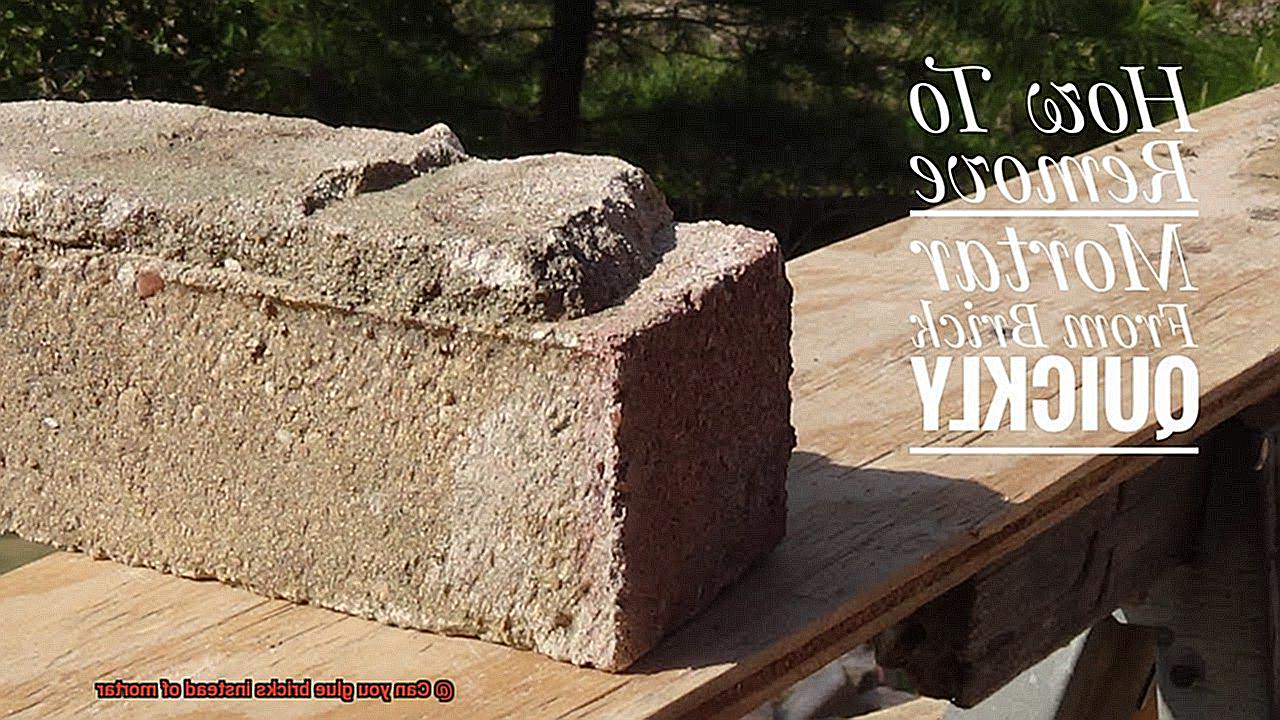
Specialized Adhesives for Specific Types of Brick Applications
In the world of brick applications, the right adhesive can make all the difference. Traditional mortar has long been the go-to choice for bricklaying projects, but specialized adhesives are gaining popularity for their ability to provide strong and durable bonds in specific applications. This article will explore the different types of specialized adhesives available for specific brick applications, explaining their uses and benefits.
Polyurethane Adhesive: Strong and Versatile
Polyurethane adhesives are known for their exceptional bonding capabilities and durability. They are suitable for both interior and exterior brick applications, withstanding extreme temperatures and weather conditions. Whether you’re building a brick wall or repairing a damaged section, polyurethane adhesives offer a reliable and long-lasting bond.
Epoxy Adhesive: High Strength and Chemical Resistance
For applications where bricks may come into contact with harsh substances, epoxy adhesive is the way to go. These adhesives are renowned for their high strength and resistance to chemicals. With epoxy adhesive, you can rest assured that your bricks will remain securely bonded, even in challenging environments.
Silicone Adhesive: Flexibility and Moisture Resistance
If you’re looking for an adhesive that can handle movement or expansion, silicone adhesive is your best bet. Silicone adhesives provide a strong bond while allowing for some degree of flexibility. They are ideal for brick facades or structures located in earthquake-prone areas. Additionally, silicone adhesives offer excellent moisture resistance, ensuring long-term protection against water damage.

Acrylic Adhesive: Easy Application and Quick Drying
For smaller-scale indoor brick projects like fireplace surrounds or decorative walls, acrylic adhesives are a convenient choice. These adhesives offer good bonding strength and resistance to weathering and UV radiation. With easy application and quick drying properties, acrylic adhesives make your brick projects hassle-free and efficient.
Thin-Set Adhesive: Perfect for Veneer Brick Installations
For veneer brick installations, thin-set adhesives are specially formulated to provide a secure bond. These adhesives are designed to be applied in a thin layer, ensuring that the bricks remain firmly in place while maintaining an aesthetically pleasing appearance. Thin-set adhesives are ideal for adding a touch of brick elegance to your interior walls or exterior surfaces.
mA-xRl0Bzmo” >
Conclusion
In conclusion, while it may seem tempting to glue bricks instead of using traditional mortar, it is not a recommended practice.
Mortar serves an essential purpose in providing structural integrity and stability to brick structures. Glue lacks the necessary strength and flexibility to withstand the pressures and movements that bricks undergo over time.
So, while gluing bricks may offer a temporary fix, it is not a long-term solution for constructing durable and reliable brickwork.

